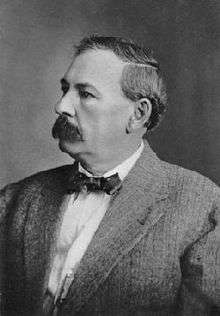Frank L. Houx
| Frank Lee Houx | |
|---|---|
 | |
| 10th Governor of Wyoming | |
|
In office February 26, 1917 – January 6, 1919 | |
| Preceded by | John B. Kendrick |
| Succeeded by | Robert D. Carey |
| 6th Secretary of State of Wyoming | |
|
In office 1911–1919 | |
| Governor |
Joseph M. Carey John B. Kendrick himself |
| Preceded by | William Schnitger |
| Succeeded by | William E. Chaplin |
| Personal details | |
| Born |
December 12, 1854 near Lexington, Missouri |
| Died |
April 3, 1941 (aged 86) Cody, Wyoming |
| Political party | Democratic |
| Spouse(s) | Ida Mason Christy (his second marriage) |
| Profession | Cattle rancher |
| Religion | Presbyterianism |
Frank Lee Houx (December 12, 1854– April 3, 1941) was an American politician, who served as the tenth Governor of Wyoming.
Houx was born near Lexington, Missouri, the second of five children of George W. Houx and Fannie (Price) Houx. The elder Houx served in the Confederate States Army under General Sterling ("Old Pap") Price, a distant cousin, and uncle of his wife. The future Governor grew up on his father's farm.
Houx married Augusta Camp in 1875, and sired two daughters and a son. (The birth year of Frank Houx is variously listed as 1854, 1859, and 1860; given his 1875 marriage, 1854 is accepted.)
He took up the study of law, reading in the office of John S. Blackwell, of Lexington, Missouri. Houx did not complete his course, however, turning his attention to commercial interests. He graduated from Shaw's Business College in Kansas City, Missouri in 1884. The next year, he moved to Montana and went into the cattle business. In 1895, he took up residence in Cody, Wyoming, where he went into politics.
On April 10, 1898, he was widowed. The next year, he remarried Ida Mason Christy, with whom he had one son and three daughters.
For a time, Houx was associated with Colonel William F. Cody ("Buffalo Bill"), in the construction of the Cody canal and other projects.
In 1901 when the town of Cody was incorporated, he first sought office, becoming the town's first Mayor. During his first term as Mayor, he also served as police judge from 1902 to 1903. He was re-elected to a second mayoral term in 1905. During the next four years, the town built a residence for him; this two-story A-frame building still stands, and now serves as a bed and breakfast known as the "Mayor's Inn."
In 1910, he became the first Democrat to be elected Secretary of State of Wyoming, an office to which he was re-elected in 1914. When Governor John B. Kendrick resigned his office on February 26, 1917 after being elected to the United States Senate, Houx became Acting Governor, and he served until the expiration of Kendrick's term, leaving office on January 6, 1919.
During his service as governor during World War I, Houx mobilized the National Guard of Wyoming for federal service, appointed the Wyoming Council for National Defense, and nominated persons to administer the Selective Service draft. He was an advocate of prison reform and a proponent of Prohibition.
He sought election as governor in his own right in 1918, but was defeated by Republican candidate Robert D. Carey. Houx then went into the oil refining business in Texas, but returned to Cody in 1935. He died in the famous Irma Hotel in Cody in 1941 at the age of 86, and was interred in Cody Cemetery. The autobiography he wrote in 1939 was published in serial form by the Cody Enterprise (newspaper) in the months following his death.
References
- Wyoming State Archives biography. Accessed 2007-08-04.
- National Governors Association biography. Accessed 2007-08-04.
- HistoryBuff.com State Facts - Wyoming. Accessed 2005-11-10.
External links
| Political offices | ||
|---|---|---|
| Preceded by William Schnitger |
Secretary of State of Wyoming 1911-1919 |
Succeeded by William E. Chaplin |
| Preceded by John B. Kendrick |
Governor of Wyoming February 26, 1917 – January 6, 1919 |
Succeeded by Robert D. Carey |
